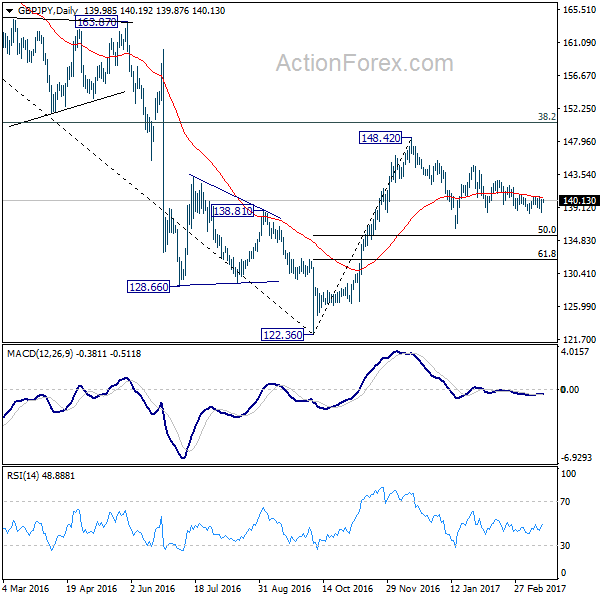Dollar is set to end the week as the worst performing major currency as post FOMC weakness continues. Meanwhile, Euro follows as the second weakest one after the positive impact of ECB and then Dutch election fades. Meanwhile, Australia dollar is leading the way high on solid risk appetite. And that is followed by Sterling which was lifted by hawkish BoE minutes yesterday. The forex markets are mixed elsewhere.
In other markets, the boost from FOMC to stocks was rather short lived as major indices ended mixed overnight. DJIA closed down -15.55 pts, or -0.07%, kept well below historical high at 21169.11. S&P 500 also closed down -3.88 pts, or -0.16%, at 2381.38, well below historical high at 2400.98. NASDAQ, on the other hand, attempted to hit record high at 5911.79 but reached 5911.48 only and closed at 5900.76, up 0.71 pts or 0.01%.
Treasury yields stabilized with TNX ended up 0.014 at 2.522. Meanwhile, WTI crude oil extends this week’s consolidation and hovers around 49. Gold rebounded strongly on Dollar weakness and is back at around 1230.
ECB Nowotny: Could raise deposit rate earlier than prime rate
There has been some recent speculations that ECB would raise interest rate before ending the quantitative easing program. ECB governing council member Ewald Nowotny said in a newspaper interview that the central bank "will decide when the time comes". He explained that "there is the American model to end the bond purchases first. Whether this model can be applied to Europe on a like-for-like basis would need to be discussed." Meanwhile, "the structure of the interest rates does not always need to remain constant." And, "the ECB could also raise the deposit rate earlier than the prime rate."
The result of the Dutch elections was welcomed by European leaders in general. European Commission President Jean-Claude Juncker responded to the result of Dutch election and said that "the people of the Netherlands voted for "free and tolerant societies in a prosperous Europe". German Chancellor Merkel noted that she believed "many people are [glad] that a high turnout led to a very pro-European result". Centrist French presidential candidate Emmanuel Macron described it as "a breakthrough for the extreme right is not a foregone conclusion". Dutch Mark Rutte retained power and his pro-EU centre-right VVD remained the biggest party. Meanwhile, the anti-EU PVV party received just 13% of the vote share. The next closely-watched political event is the French presidential election is scheduled on April 23.
The Queen gave Royal Assent to Brexit bill
In UK, the Queen has given her Royal Assent to the Brexit bill. And, Prime minister Theresa May is reading to trigger Article 50 for Brexit negotiation with EU. Brexit Secretary David Davis said that "by the end of the month we will invoke Article 50, allowing us to start our negotiations to build a positive new partnership with our friends and neighbors in the European Union, as well as taking a step out into the world as a truly Global Britain."
Sterling remains supported by the hawkish BoE minutes released yesterday. To our, and the market’s, surprise, BOE’s Kristin Forbes voted in favor of a 25 bps rate hike. While this had not altered the decision of keeping the Bank rate unchanged at 0.25%, the overall message sent to the public has now become more hawkish. The members voted unanimously to leave the government bond purchases at 435B pound and corporate bond purchases at up to 10B pound. Adding to the rising speculations of tightening is the minutes, which suggested that some of those who voted for unchanged policy believed ‘it would take relatively little further upside news on the prospects for activity or inflation for them to consider that a more immediate reduction in policy support might be warranted’. More in Forbes’ Dissent Would Unlikely Speed Up BOE’s Rate Hike Schedule
On the data front…
New Zealand business NZ manufacturing index rose to 55.2 in February. Eurozone will release Trade balance in European session. In US session, Canada will release manufacturing shipments. US will release industrial production, capacity utilization, U of Michigan sentiment and leading indicators.
GBP/JPY Daily Outlook
Daily Pivots: (S1) 138.73; (P) 139.67; (R1) 140.25; More…
GBP/JPY had another attempt at 138.53 support but rebounded from there again. The cross is staying in range of 138.53/142.79 and intraday bias remains neutral first. Price actions from 148.42 are viewed as a consolidation pattern. On the downside, break of 138.53 support will bring deeper decline to 136.44 support and possibly below. However, we’d expect strong support at 50% retracement of 122.36 to 148.42 at 135.39 to bring rebound. On the upside, above 142.79 will turn bias back to the upside for 144.77 and above.
In the bigger picture, price actions from 122.36 medium term bottom are still seen as a corrective pattern. Main focus is on 38.2% retracement of 195.86 to 122.36 at 150.42. Rejection from there will turn the cross into medium term sideway pattern with a test on 122.36 low next. Though, sustained break of 150.42 will extend the rebound towards 61.8% retracement at 167.78.


Economic Indicators Update
| GMT | Ccy | Events | Actual | Forecast | Previous | Revised |
|---|---|---|---|---|---|---|
| 21:30 | NZD | Business NZ Manufacturing Index Feb | 55.2 | 51.6 | 52.2 | |
| 10:00 | EUR | Eurozone Trade Balance (EUR) Jan | 22.3B | 24.5B | ||
| 12:30 | CAD | Manufacturing Shipments M/M Jan | 2.30% | |||
| 13:15 | USD | Industrial Production Feb | 0.30% | -0.30% | ||
| 13:15 | USD | Capacity Utilization Feb | 75.50% | 75.30% | ||
| 14:00 | USD | U. of Michigan Confidence Mar P | 97 | 96.3 | ||
| 14:00 | USD | Leading Indicators Feb | 0.20% | 0.60% |













